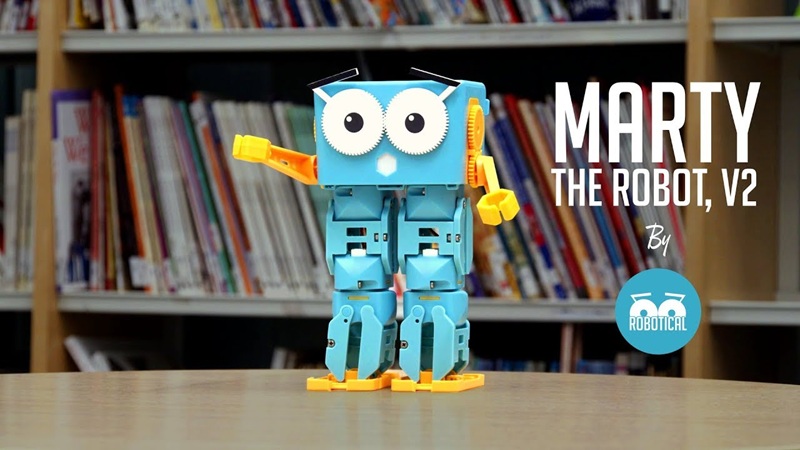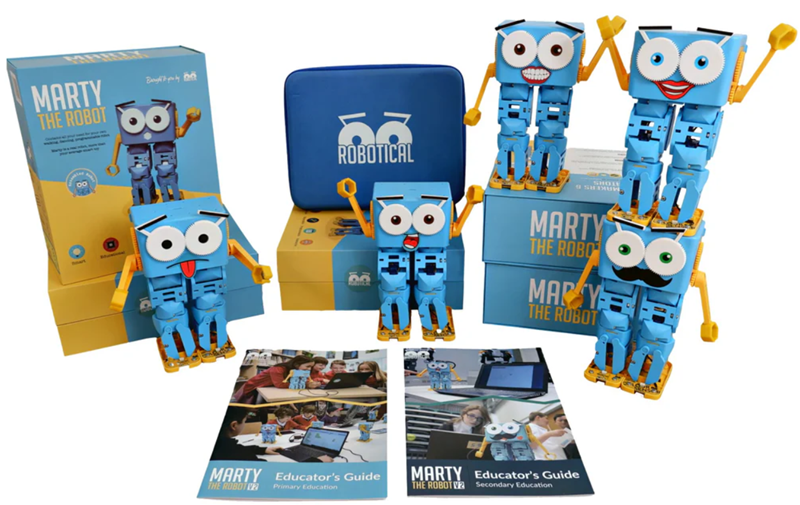- Home > News > Educational robots > Marty educational robot for learning to code
Marty Educational Robot: Walker, Dancer, Programmable
Educational robots
Does coding seem inaccessible to young learners? Marty robot revolutionises learning by making programming tactile and captivating. This humanoid robot walks, dances, reacts to its environment using proximity, colour and tilt sensors, and adapts to children from 4 years old through screen-free activities, right up to secondary school students with Python or AI.
Transforming abstract concepts into concrete experiences, it stimulates creativity, logical thinking and teamwork, while offering a progressive learning path that is praised by 92% of teachers. With its fun and educational approach, it is the ideal ally for a successful introduction to coding.
What is Marty, the robot companion that makes coding fun?
A friend to discover robotics and programming
Marty is a humanoid robot that walks, dances, greets and even expresses emotions thanks to its movable eyebrows. Designed for children aged 4 and up, it offers two options: buy the kit for a first assembly experience or choose the pre-assembled version. Available on Robot Advance, this educational companion combines technology and creativity. It adapts to all levels, from screen-free learning for younger children to advanced languages such as Python. With its nine intelligent servomotors and humanoid form, Marty quickly becomes a familiar friend to children, promoting engagement and emotional connection.

Physical computing: seeing your code come to life
The concept of physical computing allows you to instantly see your code come to life through Marty's real movements. Unlike abstract exercises, here, each line of code translates into a concrete action: a dance, a wave, or a step to the side. Marty transforms learning into an interactive game. According to one study, 92% of teachers see an improvement in STEM skills thanks to this approach.
Marty becomes a collaborative tool, stimulating creativity and team problem-solving. Thanks to its built-in sensors (position, tilt, proximity, force, infrared obstacles and colour detection), Marty reacts to its environment and can be programmed for customised interactions. It can even talk and play sounds, making learning multi-sensory and captivating.
A progressive learning path, from nursery school to secondary school
From first steps without a screen to text code
Marty supports learners aged 4-5 with offline activities to stimulate logic without a screen. For 5-7 year olds, the Marty Controller uses symbols to teach sequencing. From 6-8 years old, Blocks Jr (inspired by ScratchJr) allows children to programme movements using coloured blocks, interacting with the Robotical Cog for light and sound effects. Finally, from the age of 8, Blocks (based on Scratch) paves the way for Python, with projects such as the Marty Army to control multiple robots in sync via Wi-Fi or USB. This progression ensures learning is tailored to the child's progress, from nursery school to secondary school.
Developing essential 21st century skills
Teachers emphasise that Marty makes learning 92% more fun, and 89% of educators consider it essential for future skills. Here are the key skills:
- Computational thinking: Breaking down challenges into simple steps, as explained by one teacher: ‘It allows learners to experiment with cause and effect.’
- Creativity: Customising Marty's movements, as in the ‘Street Fighter Marty’ project where he throws out provocations, or exploring AI with machine learning algorithms.
- Teamwork: 92% of teachers note an improvement in collaboration through group projects. As C. Lynch points out: ‘Marty promotes behaviour management and collective work, even in special education.’
- Digital literacy: Understand how technologies work through sensors (noise, movement) and simple interfaces, with free educational resources for educators.
With 4.7/5 teachers recommending Marty, this educational robot stands out for its ability to make coding tangible and accessible.
Technical capabilities at the service of interactivity
A robot that moves, dances and explores its world
Marty transforms learning into an adventure with his dynamic movements. Not only can he walk and dance, but he can also perform side steps, spin around and even kick. These abilities make it possible to programme a variety of action sequences, ideal for illustrating coding concepts in a concrete way.
Imagine a robot performing a Scottish dance by synchronising its arm and leg movements, or reacting to a change in light by starting to walk. These interactions capture attention and make learning fun, unlike static robots.

Equipped with sensors for intelligent interaction
Equipped with sensors comparable to ‘senses’, Marty perceives his environment and acts autonomously. His proximity sensors prevent collisions with walls, while his colour sensor adapts his reactions according to the floor covering. The built-in accelerometer detects his position (standing, tilted or fallen), opening up possibilities for reactive programmes. Finally, the speaker adds an immersive sound dimension.
- Proximity and obstacle sensors: Marty avoids obstacles through proactive detection of his environment.
- Colour sensor: Behaviour adapts according to the colour of the floor (red, green, blue, etc.).
- Position and tilt sensors (accelerometer): Detection of his posture for contextual reactions.
- Built-in speaker: Sounds and voices add immersive feedback to interactions.
These sensors make it possible to create programmes where Marty reacts in real time, as if he possessed a form of intelligence. For children, this is an opportunity to understand the link between code and physical behaviour in a concrete way, without unnecessary technological complexity.
An evolving robot for projects with unlimited creativity
Marty is not a static robot. He adapts to your imagination thanks to his many expansion possibilities. Add a light or noise sensor so he can react to his environment. Want to do some advanced programming? Connect a Raspberry Pi or micro:bit to Marty's head. 3D-printable kits even let you create custom accessories: why not give him a unique hat or hands tailored to your projects?
Customise and enhance your Marty
Transform Marty according to your ideas. The distance sensor allows him to detect obstacles, while a Raspberry Pi paves the way for Python and the ROS system. These professional tools, accessible even to novices, make the robot scalable.
Need a specific accessory? Print it in 3D! From luminous eyes to modified legs, the possibilities are endless.
Some project ideas to get you started
- Ages 4–5 (no screen): Create direction and dance cards. Children organise a choreography on paper and then test their instructions physically with Marty.
- Primary school (with Scratch/Blocks): Turn Marty into a goalkeeper. Program his lateral movements to stop a ball, using coloured blocks in an intuitive interface.
- Secondary school (with Python): Use the proximity sensor to make Marty greet visitors or change the colour of his LED eyes depending on the distance, using simple commands such as my_marty.get_distance_sensor().
What teachers think and how to get off to a good start
A tool acclaimed by the world of education
92% of teachers say Marty makes learning fun, turning abstract concepts into concrete games. 89% consider it a valuable investment for their classroom, and 92% see a marked improvement in science, technology, engineering and mathematics (STEM) skills:
- Marty makes learning fun.
- A valuable investment for your classroom.
- Improved STEM skills among your students.
A comprehensive ecosystem to support users
Robotical, Marty's creator, offers comprehensive support. Teachers have access to free lesson plans, a knowledge base with guides and FAQs, and a blog dedicated to programming.
This offer includes personalised virtual training, guides aligned with international school curricula, and technical support for coding environments (Scratch, Python, etc.). Even those new to robotics can quickly find their feet thanks to clear resources adapted to all levels.










